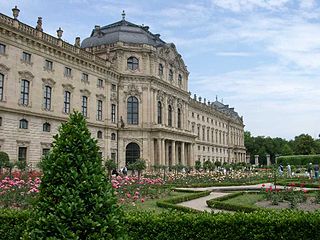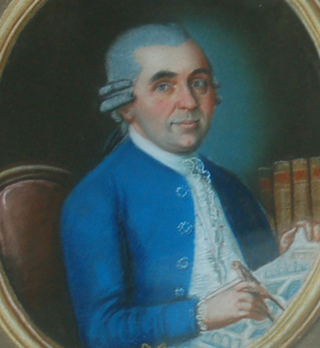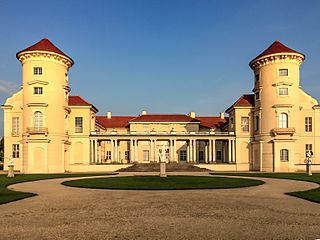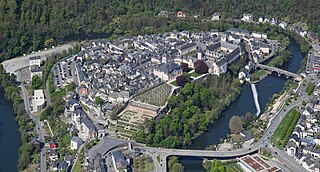
The Englischer Garten is a large public park in the centre of Munich, Bavaria, stretching from the city centre to the northeastern city limits. It was created in 1789 by Sir Benjamin Thompson (1753–1814), later Count Rumford, for Prince Charles Theodore, Elector of Bavaria. Thompson's successors, Reinhard von Werneck (1757–1842) and Friedrich Ludwig von Sckell (1750–1823), advisers on the project from its beginning, both extended and improved the park.

Ludwigsburg Palace, nicknamed the "Versailles of Swabia", is a 452-room palace complex of 18 buildings located in Ludwigsburg, Baden-Württemberg, Germany. Its total area, including the gardens, is 32 ha – the largest palatial estate in the country. The palace has four wings: the northern wing, the Alter Hauptbau, is the oldest and was used as a ducal residence; the east and west wings were used for court purposes and housing guests and courtiers; the southern wing, the Neuer Hauptbau, was built to house more court functions and was later used as a residence.

The Würzburg Residence is a palace in Würzburg, Germany. Johann Lukas von Hildebrandt and Maximilian von Welsch, representatives of the Austrian/Southern German Baroque style, were involved in the construction, as well as Robert de Cotte and Germain Boffrand, who were followers of the French style. Balthasar Neumann, court architect of the Bishop of Würzburg, was the principal architect of the Residence, which was commissioned by the Prince-Bishop of Würzburg Johann Philipp Franz von Schönborn and his brother Friedrich Carl von Schönborn in 1720, and completed in 1744. The Venetian painter Giovanni Battista Tiepolo, assisted by his son, Domenico, painted frescoes in the building.

Sanssouci is a historical building in Potsdam, near Berlin. Built by Prussian King Frederick the Great as his summer palace, it is often counted among the German rivals of Versailles. While Sanssouci is in the more intimate Rococo style and is far smaller than its French Baroque counterpart, it, too, is notable for the numerous temples and follies in the surrounding park. The palace was designed and built by Georg Wenzeslaus von Knobelsdorff between 1745 and 1747 to meet Frederick's need for a private residence where he could escape the pomp and ceremony of the royal court. The palace's name is a French phrase meaning "without worries" or "carefree", emphasising that the palace was meant as a place of relaxation rather than a seat of power.

The Nymphenburg Porcelain Manufactory is located at the Nördliches Schloßrondell in one of the Cavalier Houses in front of the Nymphenburg Palace in Munich, Germany, and since its establishment in 1747 has produced porcelain of high quality. It is one of the last porcelain producers in the world where every single part is made entirely by hand.

Schloss Johannisburg is a schloss in the town of Aschaffenburg, in Franconia, in the state of Bavaria, Germany. It was erected between 1605 and 1614 by the architect Georg Ridinger for Johann Schweikhard von Kronberg, Prince Bishop of Mainz. Until 1803, it was the second residence of the Archbishop and Prince Elector of Mainz. It is constructed of red sandstone, the typical building material of the Spessart, the hills near Aschaffenburg.

The Allerheiligen-Hofkirche is a Catholic church in the Munich Residenz designed by Leo von Klenze and built between 1826 and 1837.

Bergpark Wilhelmshöhe is a landscape park in Kassel, Germany. The area of the park is 2.4 square kilometres, making it the largest European hillside park, and second largest park on a hill slope in the world. Construction of the Bergpark, or "mountain park", began in 1689 at the behest of the Landgraves of Hesse-Kassel and took about 150 years. The park is open to the public today. Since 2013, it has been a UNESCO World Heritage Site because of its monumental Baroque architecture and its unique fountains and water features.
The Bavarian Administration of State-Owned Palaces, Gardens and Lakes, also known as the Bavarian Palace Department, is a department of the finance ministry of the German state of Bavaria. Tracing its roots back into the 18th century, the administration is now best known for being in charge of Neuschwanstein Castle and the other 19th-century palaces built by Ludwig II of Bavaria.

Johann Prokop Mayer was an Austrian naturalist and botanist. He created the flower gardens at the Würzburg Residence.
The Prussian Palaces and Gardens Foundation Berlin-Brandenburg was founded by a treaty of 23 August 1994 between the German federal states of Berlin and Brandenburg as a public foundation following German reunification. The treaty came into force on 1 January 1995. The foundation is separate from the considerably larger Prussian Cultural Heritage Foundation.

Rheinsberg Palace lies in the municipality of Rheinsberg, about 100 kilometres (62 mi) northwest of Berlin in the German district of Ostprignitz-Ruppin.

The Bachwoche Ansbach is a biennial music festival in Ansbach, Germany, dedicated to the life and works of Johann Sebastian Bach, held since 1947. The main venues are the Orangerie and the great hall of the palace Residenz Ansbach, and the churches St. Johannis and St. Gumbertus. Renowned international have performed in Ansbach, including Yehudi Menuhin, Gidon Kremer, Mstislav Rostropovich, Ludwig Hoelscher, Ferdinand Leitner and Karl Richter. In recent years, guests have included John Eliot Gardiner, Philippe Herreweghe, Ton Koopman, Andreas Staier, Martin Stadtfeld and Masaaki Suzuki.

Schloss Weimar is a Schloss (palace) in Weimar, Thuringia, Germany. It is now called Stadtschloss to distinguish it from other palaces in and around Weimar. It was the residence of the dukes of Saxe-Weimar and Eisenach, and has also been called Residenzschloss. Names in English include Palace at Weimar, Grand Ducal Palace, City Palace and City Castle. The building is located at the north end of the town's park along the Ilm river, Park an der Ilm. It forms part of the World Heritage Site "Classical Weimar", along with other sites associated with Weimar's importance as a cultural hub during the late 18th and 19th centuries.

The Schloss Fantaisie is a castle, situated 3.1 miles west of the city Bayreuth in the community Eckersdorf.

Schönbusch is a historic park and Schloss near the town of Aschaffenburg in the Franconia region of Bavaria, Germany. The park was designed in the late 18th century as an English landscape garden for an Archbishop of Mainz. Various Neoclassical buildings, including the Schloss are scattered across the park. It is open to the public.

Schloss Seehof is a Schloss (palace) in Memmelsdorf, Bamberg, Germany. It was built from 1684 to 1695 as a summer residence and hunting lodge for Marquard Sebastian Schenk von Stauffenberg, Prince-bishop of Bamberg.

Bad Homburg Castle or Homburg Palace is a castle and palace in the German city of Bad Homburg vor der Höhe. Originally the residence of the Landgraves of Hesse-Homburg, it was first built in the 12th century.

Schloss Weilburg is a Baroque schloss in Weilburg, Hesse, Germany. It is located on a spur above the river Lahn and occupies about half of the area of the Old Town of Weilburg. It contains the Hochschloss, built between 1530 and 1572, which is one of the best-preserved Renaissance palaces in Hesse. In the 1700s, the palace was expanded by John Ernst, Count of Nassau-Weilburg, and his builder, Julius Ludwig Rothweil. The buildings and gardens now belong to the Verwaltung der Staatlichen Schlösser und Gärten Hessen, and they can be visited as a museum on guided tours. Parts of the palace are venues for the music festival Weilburger Schlosskonzerte, which is named after the palace.

The Antiquarium was built from 1568 to house the ducal Collection of Classical Antiquities and Library as an extension of the Munich Residenz and was converted into a ballroom soon after. It is one of the most important surviving Renaissance collection buildings.






















